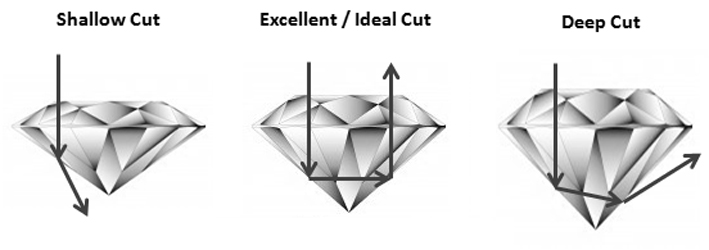The 4 C's of Diamonds
Overview of the 4 graded characteristics of diamonds, including definitions and breakdowns.
Carat

Carat Weight refers SOLELY to the weight of a diamond. This means that millimeter sizes can vary based on cut proportion and shape of a diamond. One carat equals .2 grams. Different shapes can appear larger for their given carat weight compared to other shapes. Gemstones will appear different sizes per carat as well, due to their different densities. The term carat is derived from the carob seed which was believed to have a uniform weight and was therefore used as a terms of weight measurements. Carat weight is always weighed before a stone is set to ensure complete accuracy. Carat weight is broken down into 100 equal parts called "points", very similar to the breakdown of a dollar into 100 pennies or "cents." Carat weight is always measured with a minimum acuracy of 1/100th of a carat and is frequently represented by fractions that represent a small range of different point values (i.e. 1/4ct=.21-.29, 1/3ct=.30-.38, 3/8ct=.38-.45, etc.). A melee diamond is a term that refers to any diamond .20ct or smaller in any shape. Carat weight has no impact on color, clarity and cut. Carat weight is not to be confused with Karat which refers to to the purity of gold.
Clarity

Clarity refers to the presence or absence of natural characteristics in a diamond and how visible they are to the viewer. There are several different types of natural characteristics that can occur throughout a diamond including: feathers (internal fissures), clouds (clusters of microscopic bubbles), crystals (carbon or other minerals that crystallized in a different structure than the surrounding diamond), and several others. The characteristics in diamonds are caused during the formation process as a result of the extreme heat and pressure. Clarity is graded by diamond graders at grading labs (different grading labs use a different number of diamonds graders per diamond: GIA uses 5) who will individually look at the diamond under a gemscope with 10x magnification before caucusing and mutually deciding on a grade that best fits the diamond in question. A breakdown of the different grading categories goes as follows: I3, I2, and I1 (Included) are diamonds that have high levels of prominent birthmarks that are likely to be highly visible with the naked eye, SI2 and SI1 (Slightly Included) are diamonds that have birthmarks that are less likely or not capable of being viewed with the naked eye but are clearly visible under 10x magnification, VS2 and VS1 (Very Slightly Included) are diamonds where you can no longer see the birthmarks with the naked eye and may have difficulty locating them under 10x magnification, VVS2 and VVS1 (Very Very Slightly Included) are diamonds with birthmarks so few and small that they are difficult to locate even using 10x magnification, FL and IF (Flawless and Internally Flawless) are diamonds that either have no birthmarks or have no birthmarks that could be confirmed and agreed upon by the diamond graders at the time of diamond grading. Diamond characteristics that reach the surface can sometimes chip or fracture, however, characteristics do not grow or appear in diamonds.
Color

Color refers to the natural absence or presence of body color in a diamond. Color is determined by the elements present surrounding a diamond during the formation process (i.e. the element boron causes blue coloration in diamonds). A breakdown of the different grading categories goes as follows: DEF are diamonds that are graded, by GIA, "colorless" meaning there is no body color or the diamond has a level of color that is imperceptible to the naked eye, GHIJ are diamonds that are graded "Near Colorless" meaning the level of color in the diamonds is minimal and difficult to see with the naked eye, K+ are diamonds that are graded either "Faint Color," "Very Light Color," or "Light Color" meaning the diamonds have a level of color high enough that it is easily seen with the naked eye. Natural fancy colored diamonds are graded differently and do not fall on this scale. Diamonds naturally come in all colors except a dark "emerald green." It is a misconception that all diamonds that show faint body color are "yellow," a near colorless diamond that has a faint color may have a variety of different colors that are less likely to see with the naked eye. This misconception stems from the most common naturally occurring diamond colors being yellows and browns which are much more easily visible.
Cut


Cut refers to two separate aspects of a diamond's anatomy: shape (which is the shape of a diamond at its widest point), and overall cut grade (which is usually takes into account polish and symmetry). Diamond shapes range from simple shapes such as round brilliant (which comprises 80% of all diamonds used for jewelry in the United States) to fancy shapes including decorative shapes like trapezoids and half-moon. The image above shows the most common shapes used in engagement rings. Proportion of a diamond has the greatest impact on a diamond's sparkle and brilliance. Each facet of a diamond acts as a mirror, reflecting and/or refracting light that enters the diamond. Proper angles and proportion allow a diamond to maximize the amount of light returns causing high levels of brilliance. Cut are the only man-made aspects of a diamonds' appearance. Cutting a diamond is used to enhance a diamond's brilliance (return of white light), fire (return of colored light), and scintillation (diamonds ability to tak ein and refract/reflect light and is most commonly referred to as sparkle). GIA grading laboratories grade cut (in round diamonds exclusively), polish, and symmetry on the scale: poor, fair, good, very good, and excellent. An "ideal" cut diamond is a diamond that has top level cut, polish and symmetry (excellent grade by GIA standard) and refers to a diamond that achieves high level of brilliance, fire and scintillation.
